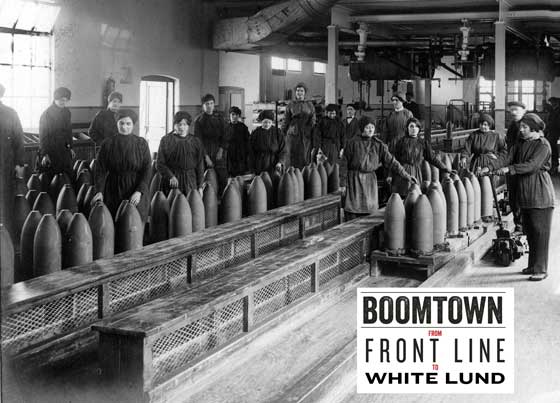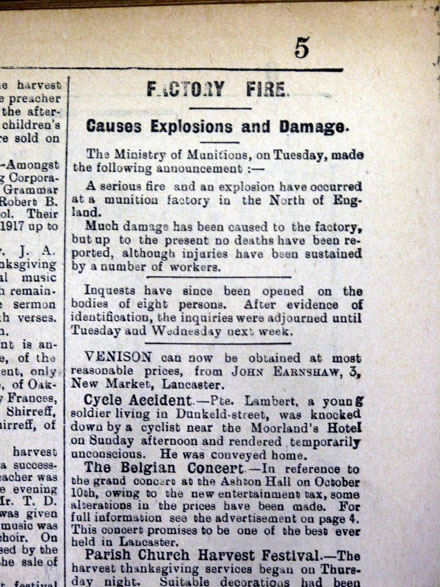The Great War Centenary
1917 - ExhibitionBoomtown - From
Front Line to White Lund
The Fire

The Fire
The exact analysis of the White Lund disaster is hard to tie down.
Investigations started soon afterwards with statements taken from many
workers and firemen. Reports were written based on the evidence of eye
witnesses and participants. However, some details do not match each
other.
Working under pressure it is not surprising that precise times were not
recorded. Without modern routes of communication it is, perhaps,
inevitable that workers and local residents would have felt panic,
feared the worst and fled wherever they thought would be safest.
We know a fire started in Unit 6C. On the ground floor workers were
filling 6" shells with powdered explosives (stemming) and, on the upper
floor, they were melting Amatol to fill 12 inch shells. It is believed
the fire started in the Melt Room on the upper floor.
Unit fitter, Fred Harrison was on duty that evening with his labourer/
assistant Firth Dole. They had eaten before the other staff and were
checking the bogies (shell transport vehicles) were fully operational
before staff returned from their dinner break. Fred Harrison went off to
the 6A stores and Firth Dole shortly went to find him:
‘Dole’s words were, “Come Fred at once I can smell fire, I am sure there
is something burning.” I do not know where Dole and [Fireman] Peck went
to, but I came along the runway connecting A, B and C of No 6 and No7
Units. I went to 6C and saw that the melted filling upstairs and down
was in flames.’
At the inquest of William Topping one witness, Richard Taylor, said what
he saw:
‘...reminded him of a sunset across the Bay – it was like a lump of
fire.’
Although great efforts were made to contain the fire, all the witnesses
tell of how quickly it grew out of control. Soon afterwards shells
started exploding.
Explosions did happen in other Filling Factories across the country. In
Leeds (National Filling Factory Number 1 at Barnbow) there were three
separate explosions in December 1916, March 1917 and March 1918. The
first of these was by far their worst with 35 women and girls tragically
killed. The deaths of the ‘Barnbow lasses’ was hushed up as part of the
country’s news blackout of sensitive information.
It is believed that the timing of the fire at White Lund saved the lives
of so many of its workers. They were mostly away from their workshops on
their supper break. Minor injuries were noted in reports but these were
sustained escaping from the site or, with some of the nursing staff, in
staying and caring for others.
On 1st October the brave actions to stem the fire - and reduce the risks
of even more shells exploding - were taken largely by staff at the works
and the local fire brigade. We believe all the deaths were sustained in
the first hours of the disaster.
With fires raging fiercely, Fire Brigades from other towns and cities
came to assist. Most arrived on site on 2nd October. They worked
tirelessly for the next 2 days. Ambulance crews also joined the
operation.
We have given a breakdown of events to give a picture of the three days
that shook the area: The Time Line

How the incident was reported in the Lancaster Guardian of 4th October
1917. Very little was said until the war was over a full article
then appeared in January 1919 when the strict regulations of the Defence
of the Realm Act were reduced.
© Images are copyright, Trustees of the King's Own Royal Regiment Museum.
You must seek permission prior to
publication of any of our images.
Only a proportion of our collections
are on display at anyone time. Certain items are on loan for display
in other institutions. An appointment is required to consult any of
our collections which are held in store.



